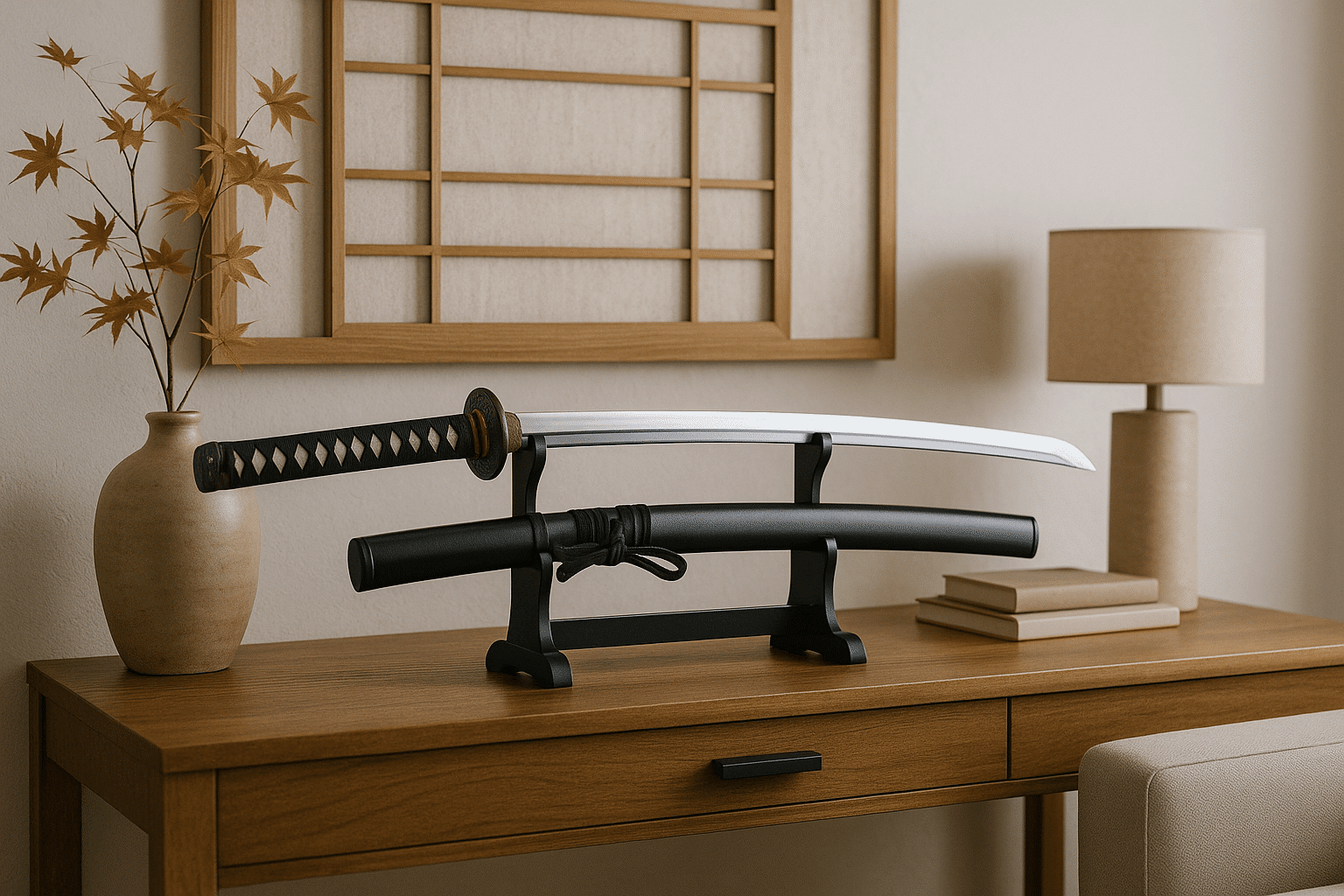The Spirit Behind the Steel
A katana is more than forged steel. It is a mirror of the one who wields it. In the hands of a samurai, it held the weight of duty and the quiet hush of inner resolve.
Every line, every curve speaks of balance. The blade is not merely shaped; it is refined—through fire, water, and will. This process echoes the path of the warrior: tested, strengthened, purified.
The katana’s presence demands respect. Not through force, but through focus. Not through fear, but through discipline.
To draw it was not an act of aggression. It was a statement of purpose. The blade stood for justice, loyalty, and restraint.
In this way, the katana held the warrior’s soul. Silent. Sharpened. Ready.
Choosing the Right Space
Choose a space where stillness lives.
Your katana is not just decor. It deserves a setting that reflects its purpose—discipline, respect, readiness. Begin by removing distractions. Loud colors, cluttered shelves, or crowded rooms diminish its presence.
Look for a place that offers quiet balance. A bare wall, a focused study, or a meditation corner. Natural light is welcome, but avoid direct sun, which can fade and damage the blade or mount.
Ensure the area is safe. Mounted securely or resting in a proper stand, the katana should be out of reach of careless hands, yet visible—a reminder of inner clarity.
The space you choose should feel intentional. No noise, no rush. Just quiet strength. Let your katana stand with dignity, and the room will follow.
Display Styles: Traditional and Modern
A katana deserves more than storage—it demands presence. Traditional katanakake stands offer quiet dignity. Usually carved from wood, they rest on shelves or alcoves, supporting the sword in a horizontal position. Blade edge up, curve facing the viewer. This style honors the sword’s past. It reflects samurai tradition and invites silent respect.
Modern displays take a different path. Wall mounts, often minimal and metal, draw clean lines across vertical surfaces. Some float the blade behind glass. Others suspend it in air with acrylic brackets. These displays emphasize design. They suit contemporary interiors without losing reverence.
Both approaches have meaning. A traditional stand reminds us of heritage. A modern mount speaks of integration—old skill in a new world. Choose based on space, intent, and the story you wish the katana to tell.
Safety First: Mounting with Care
Mounting a katana is an act of respect—for the weapon, the space, and everyone within it. Start by choosing a stable wall or stand, away from foot traffic and direct sunlight. Keep it high enough to be out of reach of children or pets, but still accessible for maintenance.
Use proper sword mounts, designed to cradle the katana securely. Horizontal mounts with the edge facing up, handle to the left, are traditional. This position honors the samurai custom and makes the blade easy to inspect without unsheathing.
Anchor mounts with care. If wall-mounted, ensure screws reach the studs. For freestanding katanakake, place it on a level surface away from vibrations or drafts.
Avoid mounting above beds or seating areas. If the katana falls, it can cause serious injury or damage. Before placing the sword, check that the mount supports its weight evenly. There should be no wobble, slip, or pressure on any part of the blade or scabbard.
Mount mindfully. The katana is not decoration. It is a presence. Treat it with quiet intention and give it the space it deserves.
Preserving the Blade: Light, Air, and Humidity
A katana is steel and spirit. Both must be protected.
Start with light. Direct sunlight can fade the handle wrap and dry out the materials. Ultraviolet rays also corrode finishes on the blade over time. Store the katana in its scabbard, away from windows and harsh light.
Next is air. Air carries dust and moisture. Together, they invite rust. Each time the blade is unsheathed, it touches the environment. Wipe it clean after every use. Apply a light coat of choji oil. This creates a barrier between steel and air.
Humidity must be controlled. High humidity promotes rust. Low humidity can crack wooden fittings. Store in a room with stable humidity—around 40 to 50 percent. A dehumidifier may help. Avoid basements or attics. Fluctuations weaken the sword’s integrity.
Protecting a katana is an act of respect. Respect for the art. Respect for the blade. Keep it in balance with its surroundings, and it will endure.
Accessories and Accents
Accessories and accents bring quiet strength to your display. Each element must serve a purpose, rooted in respect and intention.
A hand-lettered calligraphy scroll adds depth. Choose a phrase that reflects your values—patience, harmony, or courage. Mount it vertically, aligned with your focal item, to anchor the space.
Wooden plaques, carved with care, deepen the organic feel. Opt for natural finishes. Let the grain show. Honor the material.
Small scrolls or vertical banners offer traditional texture. Keep them minimal. A single character can echo loud meaning.
Every piece should align with the discipline of the dojo: nothing extra, nothing wasted. Let each item earn its place through purpose and presence.
Regular Reflection and Maintenance
Handle your blade as a samurai would—carefully, consistently, with intent.
After each use, inspect its edge. Look for chips, dull spots, or signs of rust. These are not just blemishes. They are reflections of your practice.
Wipe the blade clean. Use a soft cloth. Avoid moisture. Oil it lightly. Prevent corrosion before it begins.
Set a weekly time for deeper care. Sharpen if needed. Honor the routine. It is not upkeep—it is meditation.
This discipline is not only for the tool, but for the one who wields it. Reflection and maintenance shape both edge and mind.
Conclusion: Display with Intention
Displaying a katana is an exercise in purpose. Every choice—placement, angle, surroundings—should reflect clarity and respect. The sword is not decoration. It is discipline made visible.
Create space around it. Let the katana breathe. Empty space honors its presence and deepens its meaning. Choose a quiet place, free from distractions. Let the energy of the blade settle the room.
Face it with intention. Whether edge up or down, each position carries weight. Understand tradition. Then act with knowledge.
A well-displayed katana doesn’t shout. It speaks with stillness. Calm. Strength. Awareness.
Approach your display like a dojo—clean, focused, exact. Not to impress, but to honor. With that spirit, the katana becomes more than steel. It becomes connection.
Display with intention. Let the sword teach, even in silence.





